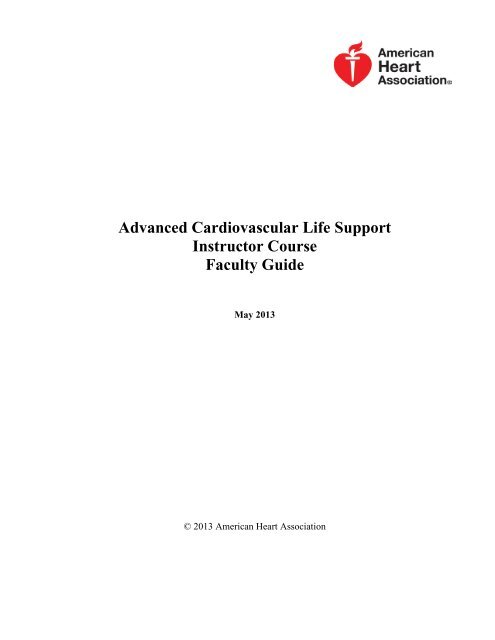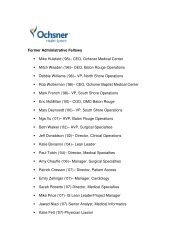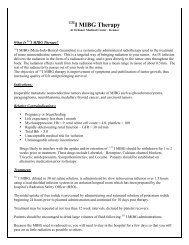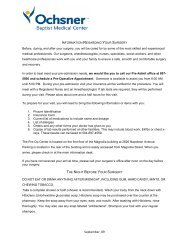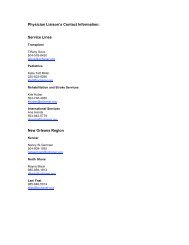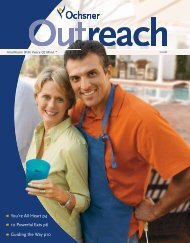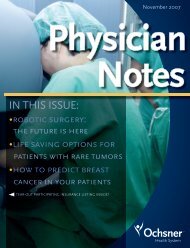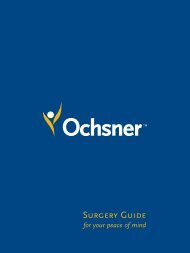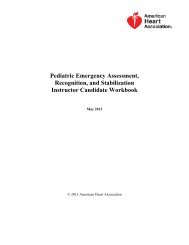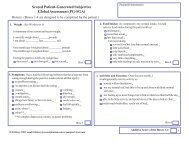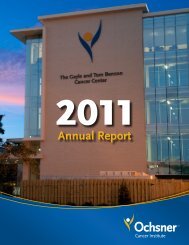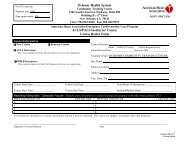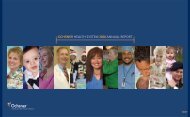ACLS Instructor Faculty Guide - Ochsner.org
ACLS Instructor Faculty Guide - Ochsner.org
ACLS Instructor Faculty Guide - Ochsner.org
You also want an ePaper? Increase the reach of your titles
YUMPU automatically turns print PDFs into web optimized ePapers that Google loves.
Advanced Cardiovascular Life Support<br />
<strong>Instructor</strong> Course<br />
<strong>Faculty</strong> <strong>Guide</strong><br />
May 2013<br />
© 2013 American Heart Association
Contents<br />
Introduction ......................................................................................................................... 3<br />
Background ......................................................................................................................... 4<br />
The Early Days ........................................................................................................... 5<br />
AHA Mission .............................................................................................................. 6<br />
AHA Global Mission .................................................................................................. 6<br />
Emergency Cardiovascular Care Mission ...................................................................... 6<br />
The Science Process and Why Materials Change Every 5 Years ............................... 7<br />
Turning Science Into Training .................................................................................... 8<br />
Making an Impact ....................................................................................................... 9<br />
The <strong>Instructor</strong>-AHA Partnership ............................................................................... 10<br />
How the <strong>ACLS</strong> <strong>Instructor</strong> Course Works ................................................................. 10<br />
Step 1: Prepare .................................................................................................................. 11<br />
Prepare Yourself ....................................................................................................... 11<br />
Find or List a Course................................................................................................. 12<br />
Prepare the Materials and Paperwork ....................................................................... 13<br />
Prepare the Equipment .............................................................................................. 15<br />
Prepare the Room ...................................................................................................... 17<br />
Prepare the <strong>Instructor</strong> Candidate ............................................................................... 19<br />
Step 2: Teach..................................................................................................................... 21<br />
Overview of Competencies ....................................................................................... 21<br />
Ethical and Professional Considerations ................................................................... 22<br />
<strong>Faculty</strong> Role and Video-Based Lessons ................................................................... 23<br />
Sample Course Agenda ............................................................................................. 25<br />
Course Outline .......................................................................................................... 26<br />
Cleaning Manikins .................................................................................................... 28<br />
<strong>ACLS</strong> and <strong>ACLS</strong> EP Audiences ............................................................................... 29<br />
Strategic Improvements ............................................................................................ 29<br />
Debriefing the Debriefer ........................................................................................... 30<br />
Step 3: Test ....................................................................................................................... 32<br />
How to Test <strong>Instructor</strong> Candidates ........................................................................... 32<br />
Monitoring <strong>Instructor</strong> Candidates ............................................................................. 32<br />
Step 4: Close ..................................................................................................................... 33<br />
Participant Evaluations ............................................................................................. 33<br />
Next Steps ................................................................................................................. 33<br />
Paperwork ................................................................................................................. 33<br />
Renewal..................................................................................................................... 33<br />
Mentoring .................................................................................................................. 34<br />
Step 5: Keep Current ......................................................................................................... 35<br />
Resources for AHA Updates ..................................................................................... 35<br />
Maintaining <strong>Faculty</strong> Status ....................................................................................... 35<br />
Forms ........................................................................................................................ 35<br />
Lesson Maps ............................................................................................................. 36<br />
2 <strong>ACLS</strong> <strong>Faculty</strong> <strong>Guide</strong>
Introduction<br />
Welcome to the American Heart Association (AHA) Advanced<br />
Cardiovascular Life Support (<strong>ACLS</strong>) <strong>Instructor</strong> Course <strong>Faculty</strong><br />
<strong>Guide</strong>. This guide is for <strong>ACLS</strong> National <strong>Faculty</strong>, Regional <strong>Faculty</strong>,<br />
and Training Center <strong>Faculty</strong> who are teaching an <strong>ACLS</strong> <strong>Instructor</strong><br />
Course.<br />
At the AHA National Center, we often get questions about how the<br />
AHA works overall and where these courses fit into the broader<br />
AHA spectrum. The following information answers those<br />
questions, and you may find it useful to share with instructor<br />
candidates.<br />
3 <strong>ACLS</strong> <strong>Faculty</strong> <strong>Guide</strong>
Background<br />
• The Early Days<br />
• AHA Mission<br />
• AHA Global Mission<br />
• Emergency Cardiovascular Care Mission<br />
• The Science Process and Why Materials Change Every 5 Years<br />
• Turning Science Into Training<br />
• Making an Impact<br />
• The <strong>Instructor</strong>-AHA Partnership<br />
• How the <strong>ACLS</strong> <strong>Instructor</strong> Course Works<br />
4 <strong>ACLS</strong> <strong>Faculty</strong> <strong>Guide</strong>
The Early<br />
Days<br />
A pioneering group of physicians and social workers formed the<br />
first Association for the Prevention and Relief of Heart Disease in<br />
New York City in 1915. They were concerned about the lack of<br />
heart disease information. At that time, patients with heart disease<br />
were considered doomed, limited to complete bed rest. So these<br />
physicians conducted studies in New York City and Boston to find<br />
out whether patients with heart disease could safely return to work.<br />
Similar groups in Boston, Philadelphia, and Chicago evolved into<br />
heart associations in the 1920s.<br />
Interest spread widely in other cities across the United States and<br />
Canada. Recognizing the need for a national <strong>org</strong>anization to share<br />
research findings and promote further study, 6 cardiologists<br />
representing several groups founded the AHA in 1924. Here is a<br />
timeline of some key dates and events in the AHA’s history:<br />
1924 The AHA was founded.<br />
1948 The AHA was transformed from a scientific<br />
society into a voluntary health agency with<br />
national headquarters located in New York City.<br />
1975 A rapidly growing AHA moved its National Center<br />
to Dallas, Texas, to better serve affiliates and local<br />
divisions nationwide.<br />
1980s<br />
Mid-1990s<br />
The AHA gained a foothold as a visible champion<br />
of public health. The AHA developed guidelines<br />
for the nation’s healthcare system and supported<br />
the federal government’s attempt to improve<br />
access to healthcare. The AHA focused its<br />
planning in 3 areas: cardiovascular science,<br />
cardiovascular education and community<br />
programs, and fundraising efforts.<br />
The AHA’s scientific findings began to move more<br />
quickly from laboratories and clinics to physicians’<br />
offices and American households.<br />
1995 The AHA’s strategic driving force for moving into<br />
the 21st century became providing credible<br />
information about heart disease and stroke for<br />
effective prevention and treatment.<br />
5 <strong>ACLS</strong> <strong>Faculty</strong> <strong>Guide</strong>
AHA Mission<br />
The AHA mission is to build healthier lives, free of cardiovascular<br />
diseases and stroke. That single purpose drives all we do.<br />
The AHA is the nation’s oldest and largest voluntary health<br />
<strong>org</strong>anization dedicated to saving people from heart disease and<br />
stroke, America’s No. 1 and No. 4 killers, respectively. The<br />
association is the trusted leader in emergency cardiovascular care<br />
and trains people around the world in how to save lives with CPR<br />
and first aid.<br />
AHA Global<br />
Mission<br />
Through collaboration with global partners and through<br />
knowledge transfer of its proven programs and strategies, the AHA<br />
strives to reduce the global burden of cardiovascular disease and<br />
stroke.<br />
Emergency<br />
Cardiovascular<br />
Care Mission<br />
The AHA’s Emergency Cardiovascular Care (ECC) Programs<br />
department is responsible for implementing program initiatives<br />
and providing guidance and support to the ECC Training Network.<br />
The ECC mission supports this responsibility.<br />
The mission of ECC Programs is to reduce disability and death<br />
from acute circulatory and respiratory emergencies, including<br />
stroke, by improving the Chain of Survival in every community<br />
and in every healthcare system.<br />
ECC Guiding Philosophy:<br />
• Improve the Chain of Survival in every community<br />
• Increase quality and timeliness of materials<br />
• Identify and expand training<br />
• Document effectiveness<br />
• Improve efficiency<br />
The goal of ECC Programs is to be the world’s premiere<br />
resuscitation <strong>org</strong>anization and serve the global community of<br />
scientists, healthcare providers, and citizens as a critical leader in<br />
discovery, processing, and transfer of resuscitation science. Its<br />
programs, products, and services focus on maximizing survival<br />
from life-threatening cardiovascular emergencies.<br />
6 <strong>ACLS</strong> <strong>Faculty</strong> <strong>Guide</strong>
The Science<br />
Process and<br />
Why<br />
Materials<br />
Change Every<br />
5 Years<br />
Scientists and physicians from the International Liaison<br />
Committee on Resuscitation (ILCOR) continuously evaluate<br />
current and new evidence about resuscitation. Every 5 years,<br />
ILCOR holds an International Consensus Conference, during<br />
which these scientists and physicians discuss and debate and then<br />
come to a consensus about the best ways to apply the science in<br />
resuscitation. This is documented in the ILCOR International<br />
Consensus on CPR and ECC Science With Treatment<br />
Recommendations.<br />
The AHA is a member council of ILCOR, and the AHA<br />
<strong>Guide</strong>lines are written on the basis of the ILCOR consensus.<br />
ILCOR International Consensus<br />
↓<br />
AHA CPR and ECC <strong>Guide</strong>lines<br />
↓<br />
ECC Training Materials<br />
This process allows the AHA to incorporate the most current<br />
science into its materials, so that faculty, instructors, and students<br />
have up-to-date information on the best practices.<br />
7 <strong>ACLS</strong> <strong>Faculty</strong> <strong>Guide</strong>
Turning<br />
Science Into<br />
Training<br />
The 2010 AHA <strong>Guide</strong>lines for CPR and ECC are based on the<br />
most current and comprehensive review of resuscitation literature<br />
ever published, the ILCOR 2010 International Consensus on CPR<br />
and ECC Science With Treatment Recommendations. The 2010<br />
evidence evaluation process included 356 resuscitation experts<br />
from 29 countries who reviewed, analyzed, evaluated, debated,<br />
and discussed research and hypotheses through in-person<br />
meetings, teleconferences, and online sessions (“webinars”) during<br />
the 36-month period before the 2010 International Consensus<br />
Conference. The experts produced 411 scientific evidence reviews<br />
on 277 topics in resuscitation and emergency cardiovascular care.<br />
The process included structured evidence evaluation, analysis, and<br />
cataloging of the literature. It also included rigorous disclosure and<br />
management of potential conflicts of interest.<br />
The recommendations in the 2010 <strong>Guide</strong>lines confirm the safety<br />
and effectiveness of many approaches, acknowledge the<br />
ineffectiveness of others, and introduce new treatments based on<br />
intensive evidence evaluation and consensus of experts.<br />
These new recommendations do not imply that care using past<br />
guidelines is either unsafe or ineffective. In addition, it is<br />
important to note that the new guidelines will not apply to all<br />
rescuers and all victims in all situations. The leader of a<br />
resuscitation attempt may need to adapt application of these<br />
recommendations to unique circumstances. The AHA may update<br />
courses if there is a published scientific breakthrough that impacts<br />
practices in our educational materials.<br />
Part of the proceeds from AHA courses goes to funding research,<br />
which means that the AHA supports the scientists whose research<br />
may one day impact our course materials.<br />
The AHA leads the charge in applying evidence-based science into<br />
every product it creates.<br />
8 <strong>ACLS</strong> <strong>Faculty</strong> <strong>Guide</strong>
Making an<br />
Impact<br />
Saving lives through training is only one way that the AHA<br />
reaches you. Here are some others:<br />
• Childhood obesity prevention<br />
• Heart-Check mark<br />
• Go Red For Women ®<br />
• Patient and consumer educational materials<br />
• Power To End Stroke ®<br />
• My Heart. My Life.<br />
• Advocacy—You’re the Cure<br />
• The <strong>Guide</strong>line Advantage<br />
• Professional education and professional membership<br />
• Mission: Lifeline ®<br />
• Research<br />
For more information visit www.heart.<strong>org</strong>.<br />
9 <strong>ACLS</strong> <strong>Faculty</strong> <strong>Guide</strong>
The<br />
<strong>Instructor</strong>-<br />
AHA<br />
Partnership<br />
The process for developing course materials is elaborate. After<br />
consensus is reached at the ILCOR meetings, the AHA writes its<br />
guidelines, and then a wide array of volunteer medical<br />
professionals work together with AHA staff, the AHA training<br />
department, and discipline-specific consultants to produce the texts<br />
and DVDs used in courses.<br />
Courses are tested by members of the AHA and AHA training<br />
network, and feedback from the test courses is incorporated into<br />
the final product. Every word and image in those texts and DVDs<br />
is evaluated, revised, and finally vetted by experts. It’s an<br />
extensive, detailed, and time-consuming process. The AHA<br />
undertakes this extensive process willingly to produce<br />
scientifically accurate and up-to-date course materials.<br />
The AHA-instructor partnership is critical to the success of the<br />
courses. The AHA develops the DVD and texts that teach the<br />
students the science. The instructors are the hands-on<br />
implementers: they evaluate, coach, remediate, and help students<br />
learn the skills.<br />
This is critical to the course’s success. The DVD can’t determine if<br />
candidates are practicing well—or learning well. The instructors<br />
are the ones who help students learn critical skills.<br />
Thank you for helping us save lives.<br />
How the<br />
<strong>ACLS</strong><br />
<strong>Instructor</strong><br />
Course<br />
Works<br />
To become an AHA <strong>ACLS</strong> <strong>Instructor</strong>, candidates need to complete<br />
an online module. This module is essentially prework, or<br />
preparation, for the classroom course, which you teach. The<br />
prework allows candidates to maximize their hands-on and<br />
practice time with you in the classroom.<br />
There are 4 steps to becoming an <strong>ACLS</strong> <strong>Instructor</strong>:<br />
1. Candidates align with a Training Center.<br />
2. Candidates take the online module.<br />
3. Candidates take the classroom course.<br />
4. Candidates are monitored as they teach.<br />
10 <strong>ACLS</strong> <strong>Faculty</strong> <strong>Guide</strong>
Step 1: Prepare<br />
• Prepare Yourself<br />
• Find or List a Course<br />
• Prepare the Materials and Paperwork<br />
• Prepare the Equipment<br />
• Prepare the Room<br />
• Prepare the <strong>Instructor</strong> Candidate<br />
Prepare<br />
Yourself<br />
<strong>Faculty</strong> should review all course materials before teaching a course.<br />
This is especially true for faculty who have not taught the course<br />
recently.<br />
Keep track of how many people are enrolled in the course.<br />
Determine how many faculty members are needed to teach and who<br />
will be lead faculty. The size for each <strong>ACLS</strong> <strong>Instructor</strong> Course is<br />
flexible, and there is currently no research-based best instructor-tostudent<br />
ratio. The practice lessons of the course, however, are<br />
designed for a ratio of 7 candidates to 1 faculty member. This will<br />
create 1 team, with 1 candidate playing the role of team leader, 5<br />
candidates playing the roles of team members, and 1 candidate<br />
acting as the instructor evaluating the “team members.”<br />
To form a team for skills practice, you need at least 3 candidates in a<br />
class.<br />
11 <strong>ACLS</strong> <strong>Faculty</strong> <strong>Guide</strong>
Find or List a<br />
Course<br />
Use the AHA’s Find a Course online tool to list the Training Center<br />
profile and/or classes scheduled. <strong>Instructor</strong> candidates are able to<br />
access this information through the online tool or by phone at 1-877-<br />
AHA-4CPR (242-4277). This tool is for US courses only.<br />
Training Center profile information is entered through the Training<br />
Center Coordinator’s access to the AHA <strong>Instructor</strong> Network.<br />
Scheduled classes can be entered through the AHA <strong>Instructor</strong><br />
Network by either Training Center Coordinators or faculty; however,<br />
faculty should check with their Training Center Coordinators for any<br />
rules or restrictions the Training Center has established regarding<br />
faculty entering their classes.<br />
Many Training Centers also have websites on which they post<br />
information about their courses.<br />
Find a Course Tool: www.heart.<strong>org</strong>/cpr<br />
AHA <strong>Instructor</strong> Network: www.ahainstructornetwork.<strong>org</strong><br />
12 <strong>ACLS</strong> <strong>Faculty</strong> <strong>Guide</strong>
Prepare the<br />
Materials<br />
and<br />
Paperwork<br />
Once you have decided when you’ll be teaching this course, order any<br />
materials you might need. Make sure you have 1 or more copies of all the<br />
books instructor candidates will refer to during the class. Also make sure<br />
that the candidates each have all the books and materials they will need.<br />
Make sure you have all additional support materials, such as posters,<br />
pocket reference cards, or emergency crash cart cards.<br />
If you need to order manikins, books, or support materials, contact an<br />
AHA distributor. The distributors are listed on the <strong>Instructor</strong> Network.<br />
Only a Training Center Coordinator can order instructor cards.<br />
The materials available for this course are listed here:<br />
Item<br />
Training<br />
Center<br />
<strong>Faculty</strong><br />
<strong>Guide</strong><br />
with<br />
Lesson<br />
Maps for<br />
<strong>ACLS</strong><br />
<strong>Instructor</strong><br />
Course<br />
<strong>ACLS</strong><br />
<strong>Instructor</strong><br />
Course<br />
DVD<br />
<strong>ACLS</strong><br />
Provider<br />
Course<br />
materials:<br />
<strong>ACLS</strong><br />
<strong>Instructor</strong><br />
Manual<br />
with<br />
Lesson<br />
Maps and<br />
<strong>ACLS</strong><br />
DVD<br />
Description<br />
Text with information<br />
about how to teach the<br />
<strong>ACLS</strong> <strong>Instructor</strong><br />
Course<br />
The DVD contains the<br />
material that<br />
candidates need to<br />
learn and that faculty<br />
use to evaluate<br />
candidates<br />
Manual, Lesson Maps,<br />
and DVD for the<br />
<strong>ACLS</strong><br />
Course<br />
Where to<br />
Get It<br />
Your<br />
Training<br />
Center<br />
Coordinator<br />
AHA<br />
distributors<br />
AHA<br />
distributors<br />
How to Use It<br />
Review it<br />
before class<br />
and use it<br />
during class<br />
Review it<br />
before class<br />
and play it<br />
during class<br />
Review them<br />
before class<br />
and use them<br />
during class;<br />
ask candidates<br />
to take out<br />
appropriate<br />
Lesson Maps<br />
when it is time<br />
for role-play<br />
lessons<br />
13 <strong>ACLS</strong> <strong>Faculty</strong> <strong>Guide</strong>
<strong>ACLS</strong><br />
<strong>Instructor</strong><br />
Candidate<br />
Workbook<br />
<strong>ACLS</strong><br />
posters<br />
Material covering the<br />
essential principles of<br />
teaching <strong>ACLS</strong><br />
Nine 4-color, 22 × 34-<br />
inch wall posters:<br />
• Cardiac Arrest<br />
Algorithm<br />
• Cardiac Arrest<br />
Circular<br />
Algorithm<br />
• Immediate<br />
Post‒Cardiac<br />
Arrest Care<br />
Algorithm<br />
• Bradycardia<br />
With a Pulse<br />
Algorithm<br />
• Tachycardia<br />
With a Pulse<br />
Algorithm<br />
• Acute<br />
Coronary<br />
Syndromes<br />
Algorithm<br />
• Suspected<br />
Stroke<br />
Algorithm<br />
• BLS<br />
Healthcare<br />
Provider<br />
Algorithm<br />
• Relationship<br />
of 12-Lead<br />
ECG to<br />
Coronary<br />
Artery<br />
Anatomy<br />
<strong>Instructor</strong><br />
Network<br />
AHA<br />
distributors<br />
Refer to this if<br />
candidates ask<br />
questions<br />
covered in the<br />
online portion<br />
of this course<br />
Use these<br />
flowcharts<br />
during roleplay<br />
lessons<br />
14 <strong>ACLS</strong> <strong>Faculty</strong> <strong>Guide</strong>
Prepare the<br />
Equipment<br />
The following table lists the required equipment for the <strong>ACLS</strong><br />
<strong>Instructor</strong> Course:<br />
Equipment and Supplies<br />
Quantity Needed<br />
Paperwork<br />
Course roster<br />
1/course<br />
Name tags<br />
1/instructor candidate and instructor<br />
Course agenda<br />
1/instructor candidate and instructor<br />
Course completion card<br />
1/instructor candidate<br />
<strong>ACLS</strong> Provider Manual<br />
1/instructor candidate and instructor<br />
ECC Handbook (optional)<br />
1/instructor candidate and instructor<br />
<strong>ACLS</strong> posters<br />
1 set/class<br />
Precourse letter<br />
1/instructor candidate<br />
Megacode Testing Checklist<br />
1/instructor candidate<br />
<strong>ACLS</strong> Provider Course written exam 1/instructor candidate<br />
Blank exam answer sheet<br />
1/instructor candidate<br />
Written exam answer key<br />
1/course<br />
<strong>ACLS</strong> <strong>Instructor</strong> Manual and <strong>ACLS</strong> 1/instructor candidate<br />
Lesson Maps<br />
Audiovisual Equipment<br />
TV with DVD player or<br />
2/course<br />
Computer with projector and screen<br />
Course DVD<br />
2/course<br />
CPR and AED Equipment<br />
Adult CPR manikin with shirt<br />
1/every 3 instructor candidates<br />
Adult airway manikin<br />
2/every 12 instructor candidates<br />
Stopwatch<br />
1/instructor<br />
Countdown timer<br />
1/instructor<br />
AED trainer with adult AED training 1/every 3 instructor candidates<br />
pads<br />
Stools to stand on for CPR<br />
1/every 3 instructor candidates<br />
Airway and Ventilation<br />
Adult pocket mask<br />
1/every 3 instructor candidates or<br />
1/instructor candidate<br />
1-way valve<br />
1/instructor candidate<br />
Bag-mask device, reservoir, and tubing 1/every 3 instructor candidates<br />
Oral and nasal airways<br />
1 set/station<br />
Water-soluble lubricant<br />
1/station<br />
Nonrebreathing mask<br />
1/every 3 instructor candidates<br />
Waveform capnography<br />
1/course<br />
Rhythm Recognition and Electrical Therapy<br />
ECG simulator/rhythm generator 1/station<br />
Electrodes<br />
1/station<br />
15 <strong>ACLS</strong> <strong>Faculty</strong> <strong>Guide</strong>
Equipment and Supplies<br />
Quantity Needed<br />
Monitor capable of<br />
1/station<br />
defibrillation/synchronized cardioversion,<br />
TCP<br />
Pacing pads, defibrillator pads, or 1/station<br />
defibrillator gel (if pads are not used)<br />
Spare batteries or power cord<br />
1/station<br />
Spare ECG paper<br />
1/station<br />
Recommended Drugs, Drug Packages, or Drug Cards<br />
Epinephrine<br />
1/station<br />
Atropine sulfate<br />
1/station<br />
Amiodarone (or lidocaine)<br />
1/station<br />
Adenosine<br />
1/station<br />
Vasopressin<br />
1/station<br />
Saline fluid bags/bottles<br />
1/station<br />
IV pole<br />
1/station<br />
Safety<br />
Sharps container (if using real needles) 1/station<br />
Advanced Airway (optional)<br />
Advanced airway skills (laryngeal mask airway, laryngeal tube, esophageal-tracheal<br />
tube, endotracheal tube) are not taught in the <strong>ACLS</strong> course but can be used by students<br />
within their scope of practice for the learning and testing stations.<br />
Cleaning Supplies for Use Between <strong>Instructor</strong> Candidate Practice and After Course<br />
Manikin cleaning supplies<br />
Varies<br />
16 <strong>ACLS</strong> <strong>Faculty</strong> <strong>Guide</strong>
Prepare the<br />
Room<br />
You can teach an average instructor course of 7 instructor candidates<br />
with 1 faculty member in 1 large room. The room should<br />
comfortably accommodate the candidates with open space at the<br />
front of the classroom for manikins, candidates, chairs, tables, and<br />
space to move around easily. An average instructor course of 14<br />
instructor candidates can be taught with 2 faculty members in 1 large<br />
room and 2 small rooms. The large room should comfortably hold at<br />
least 20 people. The smaller rooms must hold 7 candidates plus an<br />
instructor and the required equipment.<br />
The rooms should have<br />
• Good acoustics<br />
• Good lighting that can be dimmed or adjusted for video<br />
presentations<br />
• An instructor-controlled DVD player and screen large<br />
enough to be viewed by all candidates<br />
• Ideally, carpeted floors for skills practice<br />
• A chair for each instructor candidate<br />
17 <strong>ACLS</strong> <strong>Faculty</strong> <strong>Guide</strong>
Sample Room Floor Plan<br />
18 <strong>ACLS</strong> <strong>Faculty</strong> <strong>Guide</strong>
Prepare the<br />
<strong>Instructor</strong><br />
Candidate<br />
Prerequisites<br />
The instructor course is an intensive course for those individuals who<br />
have already successfully completed the discipline-specific provider<br />
course. This course is designed to train instructor candidates to<br />
conduct provider and update courses on the latest AHA guidelines<br />
and skills set for the specific discipline being taught. The role and<br />
scope of practice of healthcare providers vary greatly globally, so<br />
there are no profession-specific guidelines for becoming an AHA<br />
instructor in a specific discipline. <strong>Instructor</strong> candidates should<br />
exemplify integrity, demonstrate strong ethics, communicate clearly,<br />
and model a dedication to quality training.<br />
<strong>Instructor</strong> candidates must meet certain requirements before taking<br />
the instructor course. Before attending the <strong>ACLS</strong> classroom portion<br />
of an instructor course, all instructor candidates must<br />
19 <strong>ACLS</strong> <strong>Faculty</strong> <strong>Guide</strong><br />
• Be at least 18 years of age<br />
• Be licensed or certified in a healthcare occupation in which<br />
<strong>ACLS</strong> skills are within their scope of practice<br />
• Be aligned with an AHA Training Center<br />
• Have a current/official AHA <strong>ACLS</strong> Provider course<br />
completion card<br />
• Be proficient in the skills of <strong>ACLS</strong><br />
• Complete <strong>ACLS</strong> <strong>Instructor</strong> Essentials<br />
• Complete an <strong>Instructor</strong> Candidate Application<br />
This instructor course has 2 parts. The first part is the <strong>ACLS</strong><br />
<strong>Instructor</strong> Essentials module, which contains essential information<br />
about teaching <strong>ACLS</strong> for the AHA. Every candidate must take this<br />
module. <strong>Faculty</strong> need to take the <strong>Instructor</strong> Essentials module as well<br />
so that they know what to expect from the instructor candidates.<br />
The second part is the classroom portion, which you lead.<br />
The goal of dividing the course into online and classroom-based<br />
portions is to maximize in-class learning and make sure that<br />
candidates get as much hands-on practice time with an experienced<br />
faculty member as possible.<br />
If you have any questions about prerequisites, please consult your<br />
Training Center Coordinator or Regional <strong>Faculty</strong>, and/or refer to the<br />
Program Administration Manual (PAM).<br />
Forms<br />
We recommend sending a letter or email to candidates before the<br />
course starts. A sample of a precourse letter follows; you may edit it
to suit your needs. It should include information about when and how<br />
to return all forms and proof that all prerequisites have been met.<br />
Sample Precourse Letter to <strong>Instructor</strong> Candidates<br />
(Date)<br />
Dear <strong>Instructor</strong> Course Candidate:<br />
Welcome to the <strong>Instructor</strong> Course.<br />
When and Where<br />
The class will be<br />
Date:<br />
Time:<br />
Location:<br />
Please plan to be on time because it will be hard for late students to catch up once we start.<br />
How to Get Ready<br />
The instructor course covers a lot of material in a short time. You will have some work to<br />
complete before you come in. Your assignment is _____________________________.<br />
Please bring your <strong>Instructor</strong> Manual with Lesson Maps, Provider Manual, and <strong>Instructor</strong><br />
Candidate Workbook with you to class. They will help you learn more during the course and<br />
make you more comfortable with the material. You will also need to bring your completion<br />
certificate from the <strong>Instructor</strong> Essentials online module.<br />
What to Wear<br />
Please wear loose, comfortable clothing. You will be practicing skills that require working on<br />
your hands and knees, bending, standing, and lifting.<br />
Special Considerations<br />
If you have any physical conditions that might prevent these activities, please tell one of the<br />
faculty members before the class. The faculty may be able to adjust the equipment if you have<br />
back, knee, or hip problems. Also please tell your faculty member if you are allergic to latex.<br />
We look forward to welcoming you on (day and date of class) . If you<br />
have any questions about the course, please call (name) at<br />
(telephone number) .<br />
Sincerely,<br />
(Title)<br />
20 <strong>ACLS</strong> <strong>Faculty</strong> <strong>Guide</strong>
Step 2: Teach<br />
• Overview of Competencies<br />
• Ethical and Professional Considerations<br />
• <strong>Faculty</strong> Role and Video-Based Lessons<br />
• Using Lesson Maps<br />
• Sample Course Agenda<br />
• Course Outline<br />
• Cleaning Manikins<br />
• <strong>ACLS</strong> and <strong>ACLS</strong> EP Audiences<br />
• Strategic Improvements<br />
• Debriefing the Debriefer<br />
Overview of<br />
Competencies<br />
The goal of this course is to prepare candidates to teach <strong>ACLS</strong><br />
Provider classes. Each of the learning stations is designed to help<br />
students learn in situations that are as close to real life as<br />
possible. Educational science suggests that this is one of the<br />
most effective ways to prepare students for real-life<br />
emergencies. The closer you can make the scenarios to real-life<br />
situations, the better.<br />
The candidates should be competent in all of the following:<br />
• Skills: <strong>Instructor</strong>s need to be proficient in all the skills of<br />
the disciplines they teach.<br />
• Course delivery: <strong>Instructor</strong>s need to teach AHA<br />
materials correctly and as they were intended.<br />
• Testing: <strong>Instructor</strong>s have to be able to test students<br />
effectively.<br />
• Professionalism: <strong>Instructor</strong>s need to maintain a high<br />
standard of ethics and professionalism when teaching<br />
AHA courses.<br />
• Program administration: <strong>Instructor</strong>s need to be able to<br />
manage time, space, materials, and paperwork in<br />
compliance with AHA guidelines.<br />
21 <strong>ACLS</strong> <strong>Faculty</strong> <strong>Guide</strong>
Ethical and<br />
Professional<br />
Considerations<br />
There are 2 main reasons why it’s especially important for<br />
faculty to behave impeccably when it comes to ethics and<br />
professional behavior. The first is that it’s important to the<br />
overall AHA mission, and the second is that faculty teach<br />
candidates through their actions as well as their words.<br />
<strong>Faculty</strong> and the Mission<br />
The main goal of the AHA is to save as many lives as possible.<br />
To that end, the AHA is committed to teaching lifesaving skills<br />
such as CPR.<br />
It’s crucial that instructors be prepared both to teach well and to<br />
test their students well. <strong>Faculty</strong> have the responsibility to pass<br />
candidates when, and only when, candidates are ready. If<br />
candidates aren’t ready, they won’t be able to teach and test<br />
students well, and the students may miss out on learning<br />
lifesaving skills.<br />
Ethical Teaching Under Pressure<br />
<strong>Instructor</strong>s can be under pressure to pass students who don’t<br />
necessarily have the skills to pass. Sometimes an instructor may<br />
have his boss or a friend in a class. Other times, an instructor<br />
may be worried about the repercussions for her Training Center<br />
or business if the client/student isn’t happy. Or a student may not<br />
be able to work without a course completion card, a situation<br />
that can evoke sympathy in an instructor. There are a number of<br />
complicated reasons why an instructor may be inclined to let a<br />
student pass before the student is ready.<br />
When it comes to testing and issuing course completion cards,<br />
the instructor candidates need to understand what’s at stake.<br />
<strong>Faculty</strong> can help candidates by acknowledging the complexities<br />
of some situations as well as being clear about instructor<br />
responsibilities.<br />
Ethical <strong>Faculty</strong> Behavior<br />
Model ethical behavior in all aspects of your class, especially in<br />
testing. Showing instructor candidates how to behave is far more<br />
compelling than simply telling them.<br />
22 <strong>ACLS</strong> <strong>Faculty</strong> <strong>Guide</strong>
<strong>Faculty</strong> Role<br />
and Video-<br />
Based Lessons<br />
There are 2 key elements to this course (and all AHA courses). The<br />
AHA provides the content, and the faculty make sure that instructor<br />
candidates have learned, and can adequately perform, the skills<br />
necessary for teaching a course.<br />
The AHA uses a rigorous process to determine the best practices on<br />
the basis of scientific evidence. (See the Introduction for details on<br />
how the AHA science process works.) Once the AHA guidelines are<br />
written, then the course content is determined. The content is provided<br />
in the video.<br />
The faculty implement the content, making sure that the instructor<br />
candidates know how to do the things that are shown in the video.<br />
<strong>Faculty</strong> members monitor, observe, and coach instructor candidates so<br />
that candidates are then ready to teach students. Giving candidates<br />
immediate feedback during skills practice helps them learn.<br />
Using videos and dedicating significant time to role playing are<br />
effective tools in helping candidates learn. Using the video also helps<br />
make sure that instructor courses are consistent across the world, so<br />
that all instructors learn the same skills, and Training Centers know<br />
exactly what it means if an instructor says that she has completed<br />
instructor training.<br />
Using Lesson<br />
Maps<br />
Lesson Maps tell faculty what is going on and what is coming next.<br />
<strong>Faculty</strong> use them during class to keep the class running smoothly and<br />
also to model how to use Lesson Maps for the instructor candidates. All<br />
instructors also use Lesson Maps in their courses.<br />
Some instructors don’t realize the importance of using Lesson Maps.<br />
As a result, the students don’t learn everything they need to perform in<br />
a real emergency.<br />
If the faculty emphasize the importance of using Lesson Maps, then<br />
instructors are more likely to follow them and students are more likely<br />
to learn what they need to know.<br />
23 <strong>ACLS</strong> <strong>Faculty</strong> <strong>Guide</strong>
Here’s a sample Lesson Map, with all the numbers, letters, and icons<br />
explained.<br />
Use Lesson Maps as shown here:<br />
When<br />
Before you teach<br />
As you teach<br />
Then you can<br />
Review the maps to understand<br />
• The objectives for each lesson<br />
• Your role for each lesson<br />
• The resources that you need for each lesson<br />
Follow each Lesson Map as you conduct the course.<br />
• Remind candidates what they will see in<br />
each video segment.<br />
• Make sure you have all resources and<br />
supplies ready for each lesson.<br />
• Make notes on your Lesson Maps, such as<br />
what page numbers to reference in<br />
<strong>Instructor</strong> Manuals.<br />
24 <strong>ACLS</strong> <strong>Faculty</strong> <strong>Guide</strong>
Sample<br />
Course<br />
Agenda<br />
The following is a sample course agenda. You may alter it slightly,<br />
depending on when you want to incorporate breaks.<br />
Sample Agenda for <strong>ACLS</strong> <strong>Instructor</strong> Course<br />
14 Students, 2 <strong>ACLS</strong> <strong>Faculty</strong><br />
Approximately 8.5 hours with breaks<br />
8:30 Welcome, Introductions, and Course Administration<br />
8:35 Lesson 1: <strong>ACLS</strong> <strong>Instructor</strong> Course Overview and Organization<br />
8:45 Lesson 2: Conducting <strong>ACLS</strong> Learning Stations<br />
Divide class into 2<br />
groups<br />
Lesson 3<br />
Learning/Testing Station:<br />
Management of Respiratory<br />
Arrest<br />
Lesson 4<br />
Learning/Testing Station:<br />
CPR and AED<br />
9:00 Group 1 Group 2<br />
9:30 Group 2 Group 1<br />
10:00 Break Break<br />
Divide class into 2<br />
groups<br />
Lesson 5<br />
Learning Station:<br />
Bradycardia/PEA/Asystole<br />
Lesson 6<br />
Learning Station: Tachycardia,<br />
Stable and Unstable<br />
10:15 Group 1 Group 2<br />
11:00 Group 2 Group 1<br />
One large group<br />
11:45 Lunch<br />
Divide class into 2<br />
groups<br />
Lesson 7<br />
Learning Station: Cardiac Arrest<br />
(VF/Pulseless VT)<br />
Lesson 7<br />
Learning Station: Cardiac Arrest<br />
(VF/Pulseless VT)<br />
12:30 Group 1 Group 2<br />
One large group<br />
1:15 Lesson 8: Review: Debriefing<br />
1:30 Lesson 9: Video-Driven Learning Stations<br />
1:40 Lesson 10: ACS/Stroke Learning Stations Practice<br />
2:25 Break<br />
2:40 Lesson 11: <strong>ACLS</strong> Skills Testing Stations<br />
Divide class into 2<br />
groups<br />
Lesson 12<br />
Testing Station:<br />
Megacode<br />
Lesson 12<br />
Testing Station:<br />
Megacode<br />
2:55 Group 1 Group 2<br />
One large group<br />
3:40 Lesson 13: Training Center–Specific Policies<br />
4:10 Lesson 14: Written Exam<br />
4:40 Lesson 15: Summary<br />
4:55 Course Ends/Remediation<br />
25 <strong>ACLS</strong> <strong>Faculty</strong> <strong>Guide</strong>
Course<br />
Outline<br />
Outline for <strong>ACLS</strong> <strong>Instructor</strong> Course<br />
Approximate course duration: 7.25 hours (not counting breaks and transition times)<br />
(Student-to-instructor ratio for learning stations: 7:1)<br />
Lesson<br />
Identifier<br />
<strong>ACLS</strong><br />
INSTRUCT<br />
START<br />
<strong>ACLS</strong><br />
INSTRUCT<br />
1A-1B<br />
Course Event<br />
Welcome, Introductions, and Course<br />
Administration<br />
<strong>ACLS</strong> <strong>Instructor</strong> Course Overview and<br />
Organization<br />
Type of Lesson,<br />
Minutes<br />
5<br />
<strong>ACLS</strong><br />
INSTRUCT<br />
2<br />
Conducting <strong>ACLS</strong> Learning Stations<br />
10<br />
<strong>ACLS</strong><br />
INSTRUCT<br />
3A-3B<br />
Learning/Testing Station: Management of<br />
Respiratory Arrest<br />
15<br />
<strong>ACLS</strong><br />
INSTRUCT<br />
4A-4B<br />
Learning/Testing Station: CPR and AED<br />
30<br />
30<br />
26 <strong>ACLS</strong> <strong>Faculty</strong> <strong>Guide</strong>
Lesson<br />
Identifier<br />
<strong>ACLS</strong><br />
INSTRUCT<br />
5A-5D<br />
Course Event<br />
Learning Station: Bradycardia/PEA/Asystole<br />
Type of Lesson,<br />
Minutes<br />
<strong>ACLS</strong><br />
INSTRUCT<br />
6A-6D<br />
Learning Station: Tachycardia, Stable and Unstable<br />
45<br />
<strong>ACLS</strong><br />
INSTRUCT<br />
7A-7C<br />
Learning Station: Cardiac Arrest (VF/Pulseless VT)<br />
45<br />
<strong>ACLS</strong><br />
INSTRUCT<br />
8A-8B<br />
Review: Debriefing<br />
45<br />
<strong>ACLS</strong><br />
INSTRUCT<br />
9<br />
Video-Driven Learning Stations<br />
15<br />
<strong>ACLS</strong><br />
INSTRUCT<br />
10<br />
ACS/Stroke Learning Stations Practice<br />
10<br />
45<br />
27 <strong>ACLS</strong> <strong>Faculty</strong> <strong>Guide</strong>
Lesson<br />
Identifier<br />
<strong>ACLS</strong><br />
INSTRUCT<br />
11<br />
<strong>ACLS</strong><br />
INSTRUCT<br />
12A-12B<br />
Course Event<br />
<strong>ACLS</strong> Skills Testing Stations<br />
Testing Station: Megacode<br />
Type of Lesson,<br />
Minutes<br />
15<br />
<strong>ACLS</strong><br />
INSTRUCT<br />
13A-13B<br />
<strong>ACLS</strong><br />
INSTRUCT<br />
14<br />
<strong>ACLS</strong><br />
INSTRUCT<br />
15<br />
Training Center–Specific Policies<br />
Written Exam<br />
Summary<br />
45<br />
30<br />
30<br />
15<br />
Cleaning<br />
Manikins<br />
Follow the same procedures for cleaning manikins as you would<br />
during a provider course. <strong>Instructor</strong> candidates need to know about<br />
the Equipment Decontamination <strong>Guide</strong>lines for CPR Training on<br />
the <strong>Instructor</strong> Network. Also remind them that they will need to<br />
follow their Training Center’s policies for cleaning equipment.<br />
28 <strong>ACLS</strong> <strong>Faculty</strong> <strong>Guide</strong>
<strong>ACLS</strong> and<br />
<strong>ACLS</strong> EP<br />
Audiences<br />
<strong>Instructor</strong>s need to know the difference between the audience for<br />
the <strong>ACLS</strong> Course and the audience for the <strong>ACLS</strong> for Experienced<br />
Providers (EP) Course.<br />
<strong>ACLS</strong> is designed for healthcare providers who either direct or<br />
participate in the management of cardiopulmonary arrest or other<br />
cardiovascular emergencies. The primary audience for <strong>ACLS</strong> is inhospital<br />
and out-of-hospital healthcare providers, such as<br />
physicians, nurses, paramedics, advanced EMTs, physician<br />
assistants, advanced practice nurses, nurse practitioners, residents,<br />
clinical pharmacists, and respiratory therapists.<br />
<strong>ACLS</strong> EP is designed for team leaders who manage complex<br />
cardiovascular, respiratory, and other emergencies. This course<br />
emphasizes critical thinking and critical decision-making skills.<br />
The primary audience for <strong>ACLS</strong> EP is physicians, paramedics, and<br />
emergency department/critical care nurses.<br />
Strategic<br />
Improvements<br />
In an emergency, team leaders’ and team members’ knowledge,<br />
training, appropriate equipment, and teamwork are essential for<br />
good outcomes. Each institute should strive for improvement by<br />
evaluating team performance, including team dynamics, being<br />
well familiar with the emergency equipment the institute uses, and<br />
making sure that all medicine and equipment are present during an<br />
emergency. This takes preparation, <strong>org</strong>anization, and periodic<br />
team training. Examples of strategic improvement include<br />
response time drills, real-time feedback devices for improvement<br />
of CPR quality, use of one type of manual defibrillator throughout<br />
a medical center or EMS group, a crash cart or jump bag having all<br />
the same medicine and equipment in the same location, or the<br />
strategic location of an AED.<br />
29 <strong>ACLS</strong> <strong>Faculty</strong> <strong>Guide</strong>
Debriefing<br />
the Debriefer<br />
Guiding Principles<br />
• <strong>ACLS</strong> facilitators should follow the Gather-Analyze-<br />
Summarize (GAS) format for debriefing.<br />
• Facilitators should address the main learning objectives for<br />
each case and, in particular, identify performance gaps that<br />
arise and pertain to the learning objectives.<br />
• Not all learning objectives will be covered during the<br />
debriefing, but critical errors must be discussed.<br />
• Both medical objectives and team dynamics should be<br />
discussed during each debriefing.<br />
Debriefing the Debriefer Strategies<br />
• Take notes during the debriefing, and write down exactly<br />
what was said and how it was phrased:<br />
– Did you notice something that was unusual or awkward?<br />
– Was there a particular question that was phrased poorly?<br />
– Did the debriefer fail to address a glaring performance<br />
gap?<br />
• Follow the GAS framework. For each performance gap, ask<br />
yourself:<br />
– Did the debriefer use an observation (or paraphrase a<br />
learner comment) as the basis of the discussion for the<br />
Gather section?<br />
– Did the debriefer appropriately Analyze the<br />
performance gap and close the performance gap?<br />
– Did the debriefer Summarize effectively?<br />
Failure to follow each of these steps for a particular performance<br />
gap warrants discussion during your debriefing of the debriefer.<br />
Don’t assume you know why the facilitator decided to address a<br />
specific issue in a particular way. The best way to provide good<br />
feedback is to understand why the facilitator did things the way<br />
he or she did.<br />
30 <strong>ACLS</strong> <strong>Faculty</strong> <strong>Guide</strong>
Debriefing the Debriefer Framework<br />
Observation:<br />
Debriefer<br />
Performance<br />
Gap<br />
I noticed….<br />
I heard that….<br />
I heard you<br />
saw….<br />
When you<br />
said….<br />
I observed<br />
that….<br />
Your Point of<br />
View<br />
It made me<br />
think….<br />
It made me<br />
feel….<br />
I was<br />
thinking….<br />
I was<br />
concerned….<br />
I was<br />
worried….<br />
Elicit Learner<br />
Point of View<br />
What were your<br />
thoughts at that<br />
time?<br />
What was your<br />
reasoning at<br />
that time?<br />
What did you<br />
think at the<br />
time?<br />
Discussion to<br />
Understand<br />
Learner Point<br />
of View<br />
Close<br />
Performance<br />
Gap<br />
How do you<br />
think you<br />
would alter<br />
things next<br />
time?<br />
How would you<br />
change things<br />
next time?<br />
How would<br />
your<br />
questioning be<br />
different next<br />
time?<br />
Adapted from Rudolph JW, Simon R, Raemer DB, Eppich WJ. Debriefing as formative assessment: closing<br />
performance gaps in medical education. Acad Emerg Med. 2008;15:1010-1016.<br />
31 <strong>ACLS</strong> <strong>Faculty</strong> <strong>Guide</strong>
Step 3: Test<br />
• How to Test <strong>Instructor</strong> Candidates<br />
• Monitoring <strong>Instructor</strong> Candidates<br />
How to Test<br />
<strong>Instructor</strong><br />
Candidates<br />
<strong>Instructor</strong> candidates take a written exam at the end of the<br />
course. They must score 84% or higher to pass.<br />
You can get the written exam from your Training Center<br />
Coordinator.<br />
Candidates who do not pass the written exam on the first attempt<br />
may take a second version of the test.<br />
Monitoring<br />
<strong>Instructor</strong><br />
Candidates<br />
After completing the instructor course, the instructor must be<br />
monitored by a faculty member while teaching. It may take several<br />
classes before an instructor candidate is ready to teach on her own.<br />
The faculty member determines when the candidate is ready to<br />
teach on her own. At that point, an instructor card is issued. Refer to<br />
the PAM for specific instructions about filling out an instructor<br />
card.<br />
You can get an instructor card from your Training Center<br />
Coordinator.<br />
32 <strong>ACLS</strong> <strong>Faculty</strong> <strong>Guide</strong>
Step 4: Close<br />
• Participant Evaluations<br />
• Next Steps<br />
• Paperwork<br />
• Renewal<br />
• Mentoring<br />
Participant<br />
Evaluations<br />
Get course evaluation forms from your Training Center<br />
Coordinator. Give the instructor candidates the evaluation so that<br />
they can let you know how they thought the class went: what<br />
worked and what didn’t.<br />
Evaluations are required and can be very useful tools. Looking at<br />
several sets of evaluations can show faculty which parts of their<br />
classes are working well from the candidates’ perspective.<br />
Evaluations also can show what’s confusing to candidates and<br />
where candidates might need more help; faculty can then adapt<br />
their teaching styles to help candidates learn better.<br />
As the class draws to an end, hand out evaluations to instructor<br />
candidates. Collect them when candidates are finished. Read them<br />
carefully and decide how to strengthen your teaching. Turn them<br />
in to your Training Center, along with the rest of your paperwork,<br />
according to your Training Center’s policies.<br />
Next Steps<br />
Let the instructor candidates know what they will be expected to<br />
do after this course ends. Explain how monitoring works, and<br />
remind them of the resources they have at their disposal,<br />
particularly the <strong>Instructor</strong> Network. Let them know that their<br />
Training Centers will have their own specific policies as well.<br />
Paperwork<br />
Complete the postcourse paperwork. Make sure that the roster<br />
was accurate and that you have a grade report and summary<br />
evaluation.<br />
Renewal<br />
The PAM has information on renewing instructors’ credentials.<br />
33 <strong>ACLS</strong> <strong>Faculty</strong> <strong>Guide</strong>
Mentoring<br />
Mentoring is a nonevaluative process through which both a mentor<br />
and a mentee can strengthen their skills and deepen their<br />
knowledge.<br />
<strong>Instructor</strong> candidates should master provider skills before taking this<br />
course. The teaching skills the candidates learn in this course are an<br />
important step toward mastery of <strong>ACLS</strong> instruction.<br />
After this course is completed, and after the instructor has been<br />
monitored and received an instructor card, she is ready to teach.<br />
More experienced instructors and faculty can help her become a<br />
better instructor by mentoring and sharing wisdom gleaned through<br />
years of experience. Mastering subject matter and skills takes a long<br />
time; less experienced instructors can benefit from the wisdom of<br />
more experienced instructors.<br />
<strong>Instructor</strong>s can also mentor students, particularly in terms of<br />
professionalism, team work, communication, and quality of<br />
performance. Encourage instructor candidates to mentor their<br />
students.<br />
Through conversations with mentees, mentors often strengthen their<br />
own skills. They get new perspectives, think through new<br />
challenges, and often clarify their own thinking. Mentoring is a<br />
mutually beneficial relationship. Please consider mentoring a new<br />
instructor and encourage new instructors to seek mentors.<br />
Mentoring is one the best ways to build expert instructors and,<br />
consequently, one of the best ways to help more people save lives.<br />
34 <strong>ACLS</strong> <strong>Faculty</strong> <strong>Guide</strong>
Step 5: Keep Current<br />
• Resources for AHA Updates<br />
• Maintaining <strong>Faculty</strong> Status<br />
• Forms<br />
Resources<br />
for AHA<br />
Updates<br />
Check the <strong>Instructor</strong> Network for any AHA updates. Overall, the<br />
best resources for an instructor are the Training Center and the<br />
PAM.<br />
Maintaining<br />
<strong>Faculty</strong><br />
Status<br />
To teach instructor courses, faculty need to maintain their faculty<br />
status and instructor status. Training Centers determine how faculty<br />
maintain their faculty status. <strong>Faculty</strong> who want to know more about<br />
maintaining their instructor status should refer to the PAM, which<br />
has detailed information on the subject.<br />
Forms<br />
For forms, such as the <strong>Instructor</strong> Renewal Form and Course<br />
Evaluation, please refer to the <strong>Instructor</strong> Network or consult your<br />
Training Center Coordinator.<br />
35 <strong>ACLS</strong> <strong>Faculty</strong> <strong>Guide</strong>
Lesson Maps<br />
36 <strong>ACLS</strong> <strong>Faculty</strong> <strong>Guide</strong>
<strong>ACLS</strong><br />
INSTRUCT<br />
PRE<br />
A<br />
30 to 60 Days Before Course<br />
Your Role<br />
• Determine<br />
– Number of instructor candidates<br />
– Special needs or equipment<br />
• Reserve equipment<br />
• Schedule room<br />
• Schedule additional faculty if needed<br />
• Determine course specifics<br />
Reference<br />
<strong>ACLS</strong> <strong>Faculty</strong> <strong>Guide</strong><br />
1
<strong>ACLS</strong><br />
INSTRUCT<br />
PRE<br />
B<br />
At Least 3 Weeks Before Course<br />
Your Role<br />
• Ensure that instructor candidates are sent precourse letters<br />
with materials and that the letters specify any precourse<br />
assignments<br />
• Confirm additional faculty<br />
Reference<br />
<strong>ACLS</strong> <strong>Faculty</strong> <strong>Guide</strong><br />
2
<strong>ACLS</strong><br />
INSTRUCT<br />
PRE<br />
C<br />
Day Before Course<br />
Your Role<br />
• Confirm room reservations and setups<br />
• If you need additional faculty, given the class size, coordinate<br />
with the other faculty<br />
• Make sure all equipment is available and working<br />
• Make sure all course paperwork is in order<br />
Reference<br />
None<br />
3
<strong>ACLS</strong><br />
INSTRUCT<br />
PRE<br />
D<br />
Day of Course<br />
Your Role<br />
• Greet instructor candidates as they arrive to put them at ease<br />
• Pass out supplies<br />
• Have instructor candidates fill out the course roster<br />
• Collect instructor candidates’ certificates of completion from<br />
the <strong>ACLS</strong> online module<br />
• Make a list of instructor candidate groups and how they will<br />
rotate<br />
Reference<br />
None<br />
4
<strong>ACLS</strong><br />
INSTRUCT<br />
START<br />
Welcome, Introductions, and<br />
Course Administration<br />
0:00<br />
5:00<br />
Resources<br />
• Course roster<br />
• Course agenda<br />
<strong>Instructor</strong> Candidate Role<br />
• Introduce themselves<br />
• Listen to you<br />
<strong>Instructor</strong> Candidate Objectives<br />
• Get acquainted with you and with<br />
other students<br />
Large group, all ICs<br />
Your Role<br />
• Introduce faculty<br />
• Invite instructor candidates to introduce<br />
themselves<br />
• Explain housekeeping issues, including<br />
restrooms<br />
• Explain paperwork<br />
• Explain how instructor candidates will learn by<br />
faculty-led discussions, practice-whilewatching<br />
lessons, and practice sessions<br />
• Tell the instructor candidates, “We are<br />
scheduled to end at ____”<br />
Reference<br />
None<br />
5
<strong>ACLS</strong><br />
INSTRUCT<br />
1A<br />
<strong>ACLS</strong> <strong>Instructor</strong> Course<br />
Overview and Organization<br />
0:00<br />
10:00<br />
Resources<br />
• <strong>ACLS</strong> <strong>Instructor</strong> Course DVD<br />
• AV equipment<br />
• <strong>ACLS</strong> <strong>Instructor</strong> Manual<br />
• Course agenda<br />
• Listing of instructor candidates<br />
<strong>Instructor</strong> Candidate Role<br />
• Listen to you<br />
• Ask questions<br />
<strong>Instructor</strong> Candidate Objectives<br />
• Explain course design and <strong>org</strong>anization<br />
• Explain the purpose and function of the group<br />
rotations<br />
• Explain the course completion requirements<br />
• Explain the main goals of the <strong>ACLS</strong> Course<br />
• Be familiar with the technology used in the<br />
course<br />
Large group, all ICs<br />
Your Role<br />
• Present the course overview<br />
• Tell candidates that they will be using their <strong>ACLS</strong><br />
<strong>Instructor</strong> Manuals/CDs throughout the course<br />
• Play the Course Introduction video<br />
Explain purpose of course and the following<br />
expectations:<br />
• That candidates have completed the <strong>Instructor</strong><br />
Essentials online module<br />
• That they will be evaluated as the “instructor”<br />
and as the “student” at the learning stations<br />
• That they will have to pass the instructor course<br />
written exam<br />
• That they will have to be monitored while<br />
teaching to earn their instructor cards<br />
Reference<br />
<strong>ACLS</strong> <strong>Faculty</strong> <strong>Guide</strong>, <strong>ACLS</strong> <strong>Instructor</strong> Manual<br />
6
<strong>ACLS</strong><br />
INSTRUCT<br />
1B<br />
<strong>ACLS</strong> <strong>Instructor</strong> Course<br />
Overview and Organization<br />
Details<br />
Present course overview<br />
• Explain course agenda, design, and completion requirements<br />
• Briefly discuss the <strong>ACLS</strong> Course and its importance<br />
• Explain where to find equipment lists in the <strong>Instructor</strong> Manual and<br />
the importance of having the equipment prepared before class<br />
• Stress the importance of students knowing how to use equipment<br />
• Be certain that students understand major course concepts<br />
– Importance of high-quality CPR to patient survival<br />
– Integration of effective BLS with <strong>ACLS</strong> interventions<br />
– Importance of effective team interaction and communication<br />
during resuscitation attempt<br />
• Answer instructor candidates’ questions<br />
Play Course Introduction video<br />
• Answer questions<br />
7
<strong>ACLS</strong><br />
INSTRUCT<br />
2<br />
Conducting <strong>ACLS</strong><br />
Learning Stations<br />
0:00<br />
15:00<br />
v<br />
Resources<br />
• AV equipment<br />
• <strong>ACLS</strong> <strong>Instructor</strong> Course DVD<br />
• AV equipment<br />
<strong>Instructor</strong> Candidate Role<br />
• Watch video<br />
• Ask questions<br />
<strong>Instructor</strong> Candidate Objectives<br />
• Learn how to run learning stations<br />
Your Role<br />
• Introduce the video<br />
• Show the Learning Stations video<br />
• Answer questions<br />
• Provide an overview of the learning stations<br />
• Explain that the Putting It All Together learning<br />
station combines multiple algorithms and is<br />
practice for the Megacode test<br />
• Break candidates into groups for learning station<br />
practice and assign stations<br />
• Choose one candidate to be the instructor. That<br />
“instructor” will practice running a station<br />
• Each candidate should practice being the<br />
instructor once (more if time permits) for the<br />
learning stations<br />
Reference<br />
<strong>ACLS</strong> <strong>Faculty</strong> <strong>Guide</strong>, <strong>ACLS</strong> <strong>Instructor</strong> Manual/CD<br />
8
<strong>ACLS</strong><br />
INSTRUCT<br />
3A<br />
Learning/Testing Station:<br />
Management of<br />
Respiratory Arrest<br />
3 4<br />
0:00<br />
30:00<br />
Large group, all ICs<br />
Resources<br />
• Airway manikin<br />
• OPAs, NPAs, bag-mask device<br />
• Case scenarios (<strong>ACLS</strong> <strong>Instructor</strong><br />
Manual/CD)<br />
• Management of Respiratory Arrest Bag-<br />
Mask Ventilation Testing Checklist<br />
<strong>Instructor</strong> Candidate Role<br />
• The “instructor” manages the<br />
Respiratory Arrest station<br />
• The other candidates act as students<br />
<strong>Instructor</strong> Candidate Objectives<br />
• Learn how to run the Respiratory<br />
Arrest station<br />
Your Role<br />
Teach the instructor candidates how to run the<br />
Management of Respiratory Arrest station<br />
• Either you or the candidate you designate will<br />
– Explain that instructors should show the<br />
Airway Management video: introduction and<br />
bag-mask ventilation (PWW). <strong>Instructor</strong>s also<br />
show the optional basic airway adjuncts<br />
section if needed<br />
– Explain that instructors should correct bagmask<br />
technique if needed<br />
• Choose 3 candidates (rotate them) to manage a<br />
complete airway case (testing session part 2)<br />
• Explain that instructors should show the Airway<br />
Management video: confirmation of advanced<br />
airway devices and the optional advanced airway<br />
segment if needed<br />
Reference<br />
<strong>ACLS</strong> <strong>Faculty</strong> <strong>Guide</strong>, <strong>ACLS</strong> <strong>Instructor</strong> Manual<br />
9
<strong>ACLS</strong><br />
INSTRUCT<br />
3B<br />
Learning/Testing Station:<br />
Management of Respiratory Arrest<br />
Student Testing Details<br />
Testing Session Part 2<br />
• Choose 3 instructor candidates (rotate) to go through an airway case<br />
(respiratory arrest with a pulse). Present the airway case. The “student” must<br />
– Perform full assessment, activate the emergency response system,<br />
and do a pulse check<br />
– Begin ventilations without delay<br />
– Insert NPA or OPA<br />
– Connect bag-mask device to oxygen and adjust flow rate to appropriate<br />
level<br />
– Give bag-mask ventilations for 1 minute (skills test)<br />
• The candidate acting as the instructor should critique “students” by using the<br />
skills station checklist from the <strong>ACLS</strong> Provider Manual or <strong>Instructor</strong> Manual/CD<br />
• The candidate acting as the instructor should check off “student’s” skills station<br />
checklist as each “student” demonstrates adequate management of the airway<br />
case (case scenarios can be found in the <strong>ACLS</strong> <strong>Instructor</strong> Manual/CD)<br />
10
<strong>ACLS</strong><br />
INSTRUCT<br />
4A<br />
Learning/Testing Station:<br />
CPR and AED<br />
4 3<br />
0:00<br />
30:00<br />
Resources<br />
• Adult manikin<br />
• Pocket mask<br />
• One-way valve<br />
• AED trainer<br />
• CPR and AED testing checklist<br />
• Stopwatch<br />
• Step stools<br />
<strong>Instructor</strong> Candidate Role<br />
• One candidate manages the<br />
CPR and AED station<br />
• One acts as a student<br />
<strong>Instructor</strong> Candidate Objectives<br />
• Learn to manage the CPR and<br />
AED station<br />
6 “students,” 1 “instructor,” 1 faculty<br />
Your Role<br />
Teach instructor candidates how to run the CPR and<br />
AED station<br />
• Either you or the candidate you designate will<br />
– Explain that instructors should show the CPR<br />
and AED Skills video (PWW and scenario)<br />
– Explain that instructors should correct CPR<br />
and AED technique if needed<br />
• Choose 3 instructor candidates (rotate) to be<br />
“instructors” and test other candidates (“students”)<br />
in 1-rescuer CPR and AED, using Lesson Map<br />
<strong>ACLS</strong> 4C<br />
Reference<br />
<strong>ACLS</strong> <strong>Instructor</strong> Manual/CD; <strong>ACLS</strong> Provider Manual Part 5;<br />
ECC Handbook, pocket reference cards, or crash 11<br />
cart cards
<strong>ACLS</strong><br />
INSTRUCT<br />
4B<br />
Learning/Testing Station:<br />
CPR and AED Practice and Testing<br />
Testing Details<br />
Choose 3 instructor candidates (rotate) to manage the testing station.<br />
The “instructor” should<br />
• Test 1 “student”<br />
– Fill out the CPR and AED Testing Checklist for each “student”<br />
– ”Student“ must demonstrate entire sequence of 1-rescuer CPR and AED<br />
(with pocket mask) without prompting<br />
• Carefully observe the “student” being tested<br />
– If a “student” is unsuccessful, refer the “student” for immediate remediation<br />
• Each “student” may retest 1 additional time during this station<br />
• If a “student” remains unsuccessful, refer the “student” for remediation<br />
at the end of the course<br />
• Summarize the importance of high-quality CPR to patient survival<br />
• Describe the following testing scenario:<br />
“This is a test of the 1-rescuer adult CPR and AED skills. The scene is safe and you<br />
are wearing protective gloves. A man has collapsed in front of you, and there is no<br />
risk of a head or spinal cord injury. You are the only healthcare provider on the<br />
scene. The emergency plan at the site is to activate the emergency response<br />
system. You have a pocket mask, and an AED is available. No one else knows how<br />
to use the AED.”<br />
12
<strong>ACLS</strong><br />
INSTRUCT<br />
5A<br />
Learning Station:<br />
Bradycardia/PEA/<br />
Asystole<br />
5 6<br />
0:00<br />
45:00<br />
Resources<br />
• Code cart or code kit<br />
• Algorithms<br />
• Monitor/manual defibrillator and simulator<br />
• Manikins for CPR and intubation/ventilation<br />
• Stopwatch and countdown timer<br />
• Case scenarios (<strong>ACLS</strong> <strong>Instructor</strong> Manual/CD)<br />
• Step stools<br />
<strong>Instructor</strong> Candidate Role<br />
• One candidate manages the<br />
Bradycardia/PEA/Asystole station<br />
• Six others act as students<br />
<strong>Instructor</strong> Candidate Objectives<br />
• Learn to manage the<br />
Bradycardia/PEA/Asystole station<br />
6 “students,” 1 “instructor,” 1 faculty<br />
Your Role<br />
Teach instructor candidates how to run the<br />
Bradycardia/PEA/Asystole station<br />
• Choose 3 ICs (rotate) to present cases for the<br />
team to manage, using Lesson Maps <strong>ACLS</strong> 9A-<br />
9E<br />
• Explain how to run scenarios in real time<br />
(instructors can’t speed up or slow down the<br />
process; eg, “Assume 2 minutes has elapsed”)<br />
• Debrief each IC after each case<br />
• Explain that debriefing will take place after each<br />
case scenario. ICs will learn about debriefing<br />
later in the course<br />
Reference<br />
<strong>ACLS</strong> <strong>Instructor</strong> Manual/CD; ECC Handbook, pocket<br />
reference cards, or crash cart cards<br />
13
<strong>ACLS</strong><br />
INSTRUCT<br />
5B<br />
Learning Station:<br />
Bradycardia/PEA/Asystole<br />
Details<br />
You should<br />
• Arrange candidates: 6 will be “students” and 1 will be the “instructor”<br />
• Assign and explain team roles (or have the “instructor” do it); details are on<br />
Lesson Map 5C<br />
• Explain the learning station checklist<br />
• Have the “instructor” review the algorithms (5 minutes)<br />
The “instructor” should<br />
• Discuss bradycardias: sinus, first-, second-, and third-degree AV blocks (5<br />
minutes)<br />
• Discuss H’s and T’s (5 minutes)<br />
14
<strong>ACLS</strong><br />
INSTRUCT<br />
5C<br />
Learning Station:<br />
Bradycardia/PEA/Asystole<br />
Roles<br />
Student Rotations in Learning Station Cases According to<br />
Resuscitation Team Roles<br />
The team leader will direct the actions of the other team members. (For example, the team<br />
leader will coach the airway management team member if performance of bag-mask<br />
ventilation is not making the chest rise.)<br />
Team members will perform interventions as directed by the team leader. This is an<br />
opportunity for students to practice skills and receive feedback from the team leader.<br />
Students will demonstrate effective team behaviors (eg, closed-loop communication, clear<br />
messages).<br />
For Bradycardia: The timer/recorder will check off critical action boxes on the<br />
Bradycardia Learning Station Checklist.<br />
For PEA/Asystole case management: The timer/recorder will use a stopwatch to time<br />
2-minute intervals for case management, announce each 2-minute interval for CPR<br />
switching, and record critical action times on the <strong>ACLS</strong> Code Timer/Recorder Sheet (in<br />
Appendix B of <strong>ACLS</strong> <strong>Instructor</strong> Manual or on <strong>Instructor</strong> CD) or a whiteboard. 15
<strong>ACLS</strong><br />
INSTRUCT<br />
5D<br />
Learning Station:<br />
Bradycardia/PEA/Asystole<br />
Details for Case Rotations<br />
Directions for Case Rotations (3 rotations, 6 minutes each)<br />
Start case<br />
scenario(s)<br />
(6 minutes)<br />
“<strong>Instructor</strong>s” should<br />
• Conduct the scenario in real time<br />
• Review assigned team roles from the rotation chart for this case<br />
• Ensure that “students” understand expectations of assigned roles (eg, “Your role is<br />
to use the bag-mask device to give ventilations that cause the chest to rise”)<br />
• Introduce the case by reading the case scenario (2 Bradycardia cases and 1<br />
PEA/Asystole case)<br />
• The IC should set the timer to 6 minutes<br />
• Ask the team leader to begin managing the case<br />
• The IC should observe and coach<br />
– Effective team performance<br />
– Appropriate case management<br />
– High-quality skills performance, including high-quality CPR throughout the<br />
scenario<br />
• <strong>Guide</strong> the team leader through management of the case<br />
• Stop the case after 6 minutes<br />
You should<br />
• Debrief the IC (2 minutes)<br />
• Rotate IC and team leader for the next 2 cases<br />
16<br />
Repeat for each of the 2 remaining cases (Bradycardia/PEA/Asystole)
<strong>ACLS</strong><br />
INSTRUCT<br />
6A<br />
Learning Station:<br />
Tachycardia, Stable<br />
and Unstable<br />
6 5<br />
0:00<br />
45:00<br />
Resources<br />
• Code cart or code kit<br />
• Algorithms<br />
• Monitor/manual defibrillator and simulator<br />
• Manikins for CPR and intubation/ventilation<br />
• Stopwatch and countdown timer<br />
• Case scenarios (<strong>ACLS</strong> <strong>Instructor</strong> Manual/CD)<br />
• Step stools<br />
<strong>Instructor</strong> Candidate Role<br />
• One candidate manages the<br />
Tachycardia station<br />
• Six others act as students<br />
<strong>Instructor</strong> Candidate Objectives<br />
• Learn how to run the Tachycardia<br />
station<br />
6 “students,” 1 “instructor,” 1 faculty<br />
Your Role<br />
Teach instructor candidates how to run the Tachycardia<br />
station<br />
• Either you or the candidate you designate will<br />
– Review monitor/defibrillator technology<br />
– Review Tachycardia Algorithm<br />
– Discuss tachycardias<br />
– Review team roles, responsibilities, and assignments for<br />
each case<br />
– Explain learning station checklist<br />
• 3 ICs (rotate) present cases for the team to manage<br />
• Explain that debriefing will take place after each case<br />
scenario. ICs will learn about debriefing later in the course<br />
• Debrief each IC after each case<br />
Reference<br />
<strong>ACLS</strong> <strong>Instructor</strong> Manual/CD; ECC Handbook, pocket<br />
reference cards, or crash cart cards<br />
17
<strong>ACLS</strong><br />
INSTRUCT<br />
6B<br />
Learning Station:<br />
Tachycardia, Stable and Unstable<br />
Algorithm and Tachycardia Review<br />
• Choose an instructor candidate to review the Tachycardia Algorithm (5<br />
minutes)<br />
• Have the IC review tachycardias (10 minutes)<br />
– Sinus tachycardia<br />
– Atrial fibrillation<br />
– Atrial flutter<br />
– Reentry supraventricular tachycardia<br />
– Monomorphic VT<br />
– Polymorphic VT<br />
– Wide-complex tachycardia of uncertain type<br />
• Arrange candidates: 6 will be “students” and 1 will be the “instructor”<br />
• Assign team roles (or have “instructor” do it)<br />
• Explain learning station checklist<br />
18
<strong>ACLS</strong><br />
INSTRUCT<br />
6C<br />
Learning Station:<br />
Tachycardia, Stable and Unstable<br />
Roles<br />
Student Rotations in Learning Station Cases According to<br />
Resuscitation Team Roles<br />
The team leader will direct the actions of the other team members. (For<br />
example, the team leader will coach the airway management team member if<br />
performance of bag-mask ventilation is not making the chest rise.)<br />
Team members will perform interventions as directed by the team leader.<br />
This is an opportunity for students to practice skills and receive feedback from<br />
the team leader. Students will demonstrate effective team behaviors (eg,<br />
closed-loop communication, clear messages).<br />
The timer/recorder will check off critical action boxes on the Tachycardia<br />
Learning Station Checklist.<br />
19
<strong>ACLS</strong><br />
INSTRUCT<br />
6D<br />
Learning Station:<br />
Tachycardia, Stable and Unstable<br />
Details for Case Rotations<br />
Directions for Case Rotations (3 rotations, 6 minutes each)<br />
(<strong>Instructor</strong>s must conduct the scenario in real time)<br />
Start case<br />
scenario<br />
(6 minutes)<br />
• Review assigned team roles from the rotation chart for this case<br />
– Ensure that students understand expectations of assigned roles (eg, “Your<br />
role is to use the bag-mask device to give ventilations that cause the chest to<br />
rise”)<br />
• IC introduces the case by reading the case scenario (2 unstable cases and 1<br />
stable case)<br />
• IC should set the timer to 6 minutes<br />
• IC asks the team leader to begin managing the case<br />
• “Students” may use the ECC Handbook, pocket cards, or crash cart cards<br />
• The IC should observe and coach<br />
– Effective team performance<br />
– Appropriate case management<br />
– High-quality skills performance<br />
• <strong>Guide</strong> the team leader through management of the case<br />
• The IC should stop the case after 6 minutes<br />
• Debrief the IC (2 minutes)<br />
• Rotate IC and team leader for the next 2 cases<br />
Repeat for each of the 2 remaining cases (Stable and Unstable Tachycardia)<br />
20
<strong>ACLS</strong><br />
INSTRUCT<br />
7A<br />
Learning Station:<br />
Cardiac Arrest<br />
(VF/Pulseless VT)<br />
7 7<br />
0:00<br />
45:00<br />
Resources<br />
• Code cart or code kit<br />
• Algorithms<br />
• Monitor/manual defibrillator and simulator<br />
• Manikins for CPR and intubation/ventilation<br />
• Stopwatch and countdown timer<br />
• Case scenarios (<strong>ACLS</strong> <strong>Instructor</strong> Manual/CD)<br />
• Airway manikins<br />
• Step stools<br />
<strong>Instructor</strong> Candidate Role<br />
• Three candidates rotate managing the<br />
VF/Pulseless VT station<br />
• Six ICs act as students<br />
<strong>Instructor</strong> Candidate Objectives<br />
• Learn how to run the<br />
VF/Pulseless VT station<br />
6 “students,” 1 “instructor,” 1 faculty per station<br />
Your Role<br />
Teach instructor candidates how to run the VF/Pulseless VT<br />
station<br />
• Either you or the candidate you designate will<br />
– Review monitor/defibrillator technology<br />
– Review algorithms<br />
• Cardiac Arrest Algorithm (VF/Pulseless VT)<br />
• Immediate Post–Cardiac Arrest Care Algorithm<br />
– Review team roles, responsibilities, and assignments for<br />
each case (see Lesson Maps <strong>ACLS</strong> 6B and 6C)<br />
– Students may use ECC Handbook, pocket reference<br />
cards, or crash cart cards<br />
• 3 ICs (rotate) present cases for the team to manage<br />
• Explain that debriefing will take place after each case<br />
scenario. ICs will learn about debriefing later in the course<br />
• Debrief each IC after each case<br />
Reference<br />
<strong>ACLS</strong> <strong>Instructor</strong> Manual/CD; ECC Handbook, pocket<br />
reference cards, or crash cart cards<br />
21
<strong>ACLS</strong><br />
INSTRUCT<br />
7B<br />
Learning Station:<br />
Cardiac Arrest (VF/Pulseless VT)<br />
Review Algorithms and Roles<br />
Review algorithms (5 minutes)<br />
Student Rotations in Learning Station Cases According<br />
to Resuscitation Team Roles<br />
The team leader will direct the actions of the other team members. (For<br />
example, the team leader will coach the airway management team member if<br />
performance of bag-mask ventilation is not making the chest rise.)<br />
Team members will perform interventions as directed by the team leader. This<br />
is an opportunity for students to practice skills and receive feedback from the<br />
team leader. Students will demonstrate effective team behaviors (eg, closedloop<br />
communication, clear messages).<br />
The timer/recorder will use a stopwatch to time 2-minute intervals for case<br />
management, announce each 2-minute interval for CPR switching, and record<br />
critical action times on the <strong>ACLS</strong> Code Timer/Recorder Sheet (<strong>ACLS</strong> <strong>Instructor</strong><br />
Manual/CD) or a whiteboard. 22
<strong>ACLS</strong><br />
INSTRUCT<br />
7C<br />
Learning Station:<br />
Cardiac Arrest (VF/Pulseless VT)<br />
Details for Case Rotations<br />
Directions for Case Rotations (3 rotations, 10 minutes each)<br />
(<strong>Instructor</strong>s must conduct the scenario in real time)<br />
Start case<br />
scenario<br />
(10 minutes)<br />
Repeat 2 more cases<br />
• Review assigned team roles from the rotation chart for this case<br />
– Ensure that students understand expectations of assigned roles (eg, “Your role<br />
is to use the bag-mask device to give ventilations that cause the chest to rise”)<br />
• Introduce the case by reading the case scenario<br />
• Set the timer to 10 minutes<br />
• Ask the team leader to begin managing the case<br />
• Observe and coach<br />
– Effective team performance<br />
– Appropriate case management<br />
– High-quality skills performance, including high-quality CPR throughout the<br />
scenario<br />
• <strong>Guide</strong> the team leader through management of the case<br />
• Stop the case after 10 minutes<br />
• Debrief the IC (2 minutes)<br />
• Switch IC and team leader for the next 2 cases<br />
23
<strong>ACLS</strong><br />
INSTRUCT<br />
8A<br />
Review: Debriefing<br />
0:00<br />
15:00<br />
Resources<br />
• AV equipment<br />
• <strong>ACLS</strong> <strong>Instructor</strong> Course DVD<br />
Large group, all ICs<br />
Your Role<br />
• Introduce video<br />
• Show Debriefing video<br />
• Answer questions<br />
• Review debriefing tool<br />
• Discuss challenging learners<br />
<strong>Instructor</strong> Candidate Role<br />
• Watch video<br />
• Participate in the discussion<br />
<strong>Instructor</strong> Candidate Objectives<br />
• Define debriefing and debriefing<br />
strategies<br />
Reference<br />
<strong>ACLS</strong> <strong>Faculty</strong> <strong>Guide</strong>, <strong>ACLS</strong> <strong>Instructor</strong> Manual<br />
24
<strong>ACLS</strong><br />
INSTRUCT<br />
8B<br />
Challenging Learners<br />
Lead a 5- to 10-minute discussion on challenging learners<br />
Some typical challenging learners:<br />
• Unprepared student<br />
• Anxious student<br />
• Dominating student<br />
• Bored student<br />
Some general strategies for addressing challenging learners:<br />
• Acknowledge the learner and then redirect:<br />
“Thanks for contributing, Student. Now, let’s talk about…”<br />
• Use neutral criticism, focused on the work rather than on the person:<br />
“Compressions should be at least 100/min” vs “You’re not going fast enough”<br />
• When you can, acknowledge what the student is doing well/right before introducing a criticism<br />
Some good general strategies for leading discussions:<br />
• Asking probing or open-ended questions<br />
• Listening to students and building on their comments<br />
• Clarifying student comments<br />
• Paraphrasing student comments<br />
• Encouraging quieter members to participate (“Let’s hear from someone who hasn’t spoken yet”)<br />
25
<strong>ACLS</strong><br />
INSTRUCT<br />
9<br />
Video-Driven Learning Stations<br />
0:00<br />
10:00<br />
Resources<br />
• AV equipment<br />
• <strong>ACLS</strong> <strong>Instructor</strong> Course DVD<br />
<strong>Instructor</strong> Candidate Role<br />
• Watch video<br />
• Participate in core cases<br />
Large group, all ICs<br />
Your Role<br />
• Introduce video<br />
• Show Video-Driven Learning Stations<br />
video<br />
• Answer questions<br />
• <strong>Faculty</strong> will also explain how the video<br />
lessons for BLS and <strong>ACLS</strong> Surveys and<br />
Megacode and Team Dynamics are run<br />
via Lesson Maps<br />
<strong>Instructor</strong> Candidate Objectives<br />
• Explain how to run core case<br />
scenarios<br />
Reference<br />
<strong>ACLS</strong> <strong>Faculty</strong> <strong>Guide</strong>, <strong>ACLS</strong> <strong>Instructor</strong> Manual/CD<br />
26
<strong>ACLS</strong><br />
INSTRUCT<br />
10<br />
ACS/Stroke Learning Stations<br />
Practice<br />
0:00<br />
45:00<br />
Resources<br />
• AV equipment<br />
• <strong>ACLS</strong> <strong>Instructor</strong> Course DVD<br />
Large group, all ICs<br />
Your Role<br />
• Choose one instructor candidate to lead<br />
the group through the ACS video case<br />
• Show the Acute Coronary Syndromes<br />
video<br />
• Debrief the instructor candidate<br />
<strong>Instructor</strong> Candidate Role<br />
• Watch video<br />
• One IC will lead the video case<br />
<strong>Instructor</strong> Candidate Objectives<br />
• Explain how to run the ACS station<br />
Reference<br />
<strong>ACLS</strong> <strong>Faculty</strong> <strong>Guide</strong>, <strong>ACLS</strong> <strong>Instructor</strong> Manual/CD<br />
27
<strong>ACLS</strong><br />
INSTRUCT<br />
11<br />
<strong>ACLS</strong> Skills Testing Stations<br />
0:00<br />
15:00<br />
Resources<br />
• AV equipment<br />
• <strong>ACLS</strong> <strong>Instructor</strong> Course DVD<br />
Large group, all ICs<br />
Your Role<br />
• Introduce video<br />
• Show Skills Testing video<br />
• Answer questions<br />
<strong>Instructor</strong> Candidate Role<br />
• Watch video<br />
<strong>Instructor</strong> Candidate Objectives<br />
• Understand how to test students<br />
Reference<br />
<strong>ACLS</strong> <strong>Faculty</strong> <strong>Guide</strong>, <strong>ACLS</strong> <strong>Instructor</strong> Manual/CD<br />
28
<strong>ACLS</strong><br />
INSTRUCT<br />
12A<br />
Testing Station:<br />
Megacode<br />
12 12<br />
0:00<br />
45:00<br />
Resources<br />
• Adult manikins (at least 2)<br />
• Pocket masks (1 per manikin)<br />
• One-way valves (1 per student)<br />
• AED trainers (2)<br />
• AV equipment<br />
• CPR and AED Skills video<br />
• CPR and AED testing checklist<br />
• Stopwatch<br />
• Step stools<br />
<strong>Instructor</strong> Candidate Role<br />
• One candidate manages the<br />
Megacode station<br />
• Six others act as students<br />
6 “students,” 1 “instructor,” 1 faculty<br />
Your Role<br />
Teach instructor candidates how to run the<br />
Megacode testing station<br />
• Choose 3 ICs (rotate them) to present<br />
cases for the team to manage<br />
• Explain that debriefing will not occur after<br />
testing and that instructors should give team<br />
leaders results in private<br />
• Debrief each IC after each case<br />
• Explain student remediation<br />
<strong>Instructor</strong> Candidate Objectives<br />
• Learn how to manage the<br />
Megacode station<br />
Reference<br />
<strong>ACLS</strong> <strong>Instructor</strong> Manual/CD; ECC Handbook, pocket<br />
reference cards, or crash cart cards<br />
29
<strong>ACLS</strong><br />
INSTRUCT<br />
12B<br />
Testing Station:<br />
Megacode<br />
Details for Case Rotations<br />
Directions for Case Rotations (3 rotations, 10 minutes each)<br />
(“<strong>Instructor</strong>s” must conduct the scenario in real time)<br />
Start case<br />
scenario<br />
(10 minutes)<br />
• The IC acting as the instructor introduces the case by reading the<br />
case scenario<br />
• The “instructor” sets the timer to 10 minutes<br />
• The “instructor” asks the “team leader” to begin managing the case<br />
• The “instructor” stops the case after 10 minutes<br />
• You debrief the IC (2 minutes)<br />
• Rotate IC and team leader for the next 2 cases<br />
Repeat 2 more cases<br />
30
<strong>ACLS</strong><br />
INSTRUCT<br />
13A<br />
Training Center–Specific<br />
Policies<br />
0:00<br />
30:00<br />
Resources<br />
• Training Center–specific policies<br />
Your Role<br />
• Discuss AHA and TC-specific policies<br />
• Have candidates complete the TC-specific<br />
sections of their Candidate Workbooks<br />
<strong>Instructor</strong> Candidate Role<br />
• Write answers to TC-specific<br />
questions in the Candidate<br />
Workbook<br />
<strong>Instructor</strong> Candidate Objectives<br />
• Explain TC-specific policies and<br />
where to get more information<br />
Reference<br />
None<br />
31
<strong>ACLS</strong><br />
INSTRUCT<br />
13B<br />
Training Center–Specific Policies<br />
Explain what a TC is<br />
Discuss ethics, specifically:<br />
• Appropriate behavior<br />
• Avoiding fraudulent behaviors<br />
Tell candidates the following about course materials and cards:<br />
• How to get cards<br />
• How to get and secure exams<br />
• That instructors must have their own <strong>Instructor</strong> Manuals<br />
• That students must have their own Provider Manuals before, during, and after the course<br />
• That all appropriate videos must be used in each course<br />
• That there are different skills check sheets and the right one must be used at each station<br />
• That stopwatches must be used<br />
Explain requirements, the <strong>Instructor</strong> Network, and paperwork:<br />
• Explain monitoring (including that it must be done by an RF or TCF)<br />
• Explain renewal requirements and any TC-specific requirements. Also, tell candidates that<br />
they need to keep duplicate copies of their own records<br />
• Show how to complete paperwork and discuss how to file it, including any relevant TCspecific<br />
policies<br />
• Explain the <strong>Instructor</strong> Network: how to navigate it and how to find required course materials<br />
• Have candidates review Chapter 3 of the PAM<br />
Provide any additional TC-specific policies:<br />
• Contact information for TC personnel<br />
• How to handle skills testing<br />
• Anything else specific to the TC<br />
32
<strong>ACLS</strong><br />
INSTRUCT<br />
14<br />
Written Exam<br />
0:00<br />
30:00<br />
Resources<br />
• Written exams<br />
• Blank answer sheets<br />
• Answer key<br />
<strong>Instructor</strong> Candidate Role<br />
• Take written exam<br />
<strong>Instructor</strong> Candidate Objectives<br />
• Complete instructor course<br />
written exam<br />
• Explain how to give the <strong>ACLS</strong><br />
written exam<br />
Your Role<br />
• Explain how to administer the <strong>ACLS</strong> written<br />
exam<br />
• Explain the passing score for the instructor<br />
written exam<br />
• Pass out the instructor written exam<br />
• Proctor the exam<br />
• Collect and score each exam<br />
• Review the answers by using the answer key<br />
with the candidates<br />
• Provide remediation as needed<br />
Reference<br />
<strong>ACLS</strong> <strong>Instructor</strong> Manual<br />
33
<strong>ACLS</strong><br />
INSTRUCT<br />
15<br />
Summary<br />
0:00<br />
15:00<br />
Resources<br />
• <strong>Instructor</strong> course evaluations<br />
<strong>Instructor</strong> Candidate Role<br />
• Listen to faculty<br />
• Complete course evaluation<br />
Your Role<br />
• Discuss<br />
– Next steps<br />
– Resources for finding more information<br />
• Distribute and collect course evaluations<br />
<strong>Instructor</strong> Candidate Objectives<br />
• Explain next steps and resources<br />
Reference<br />
<strong>ACLS</strong> <strong>Faculty</strong> <strong>Guide</strong><br />
34


